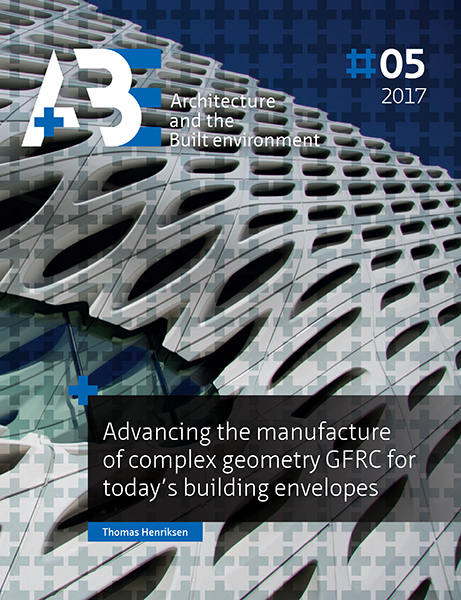Advancing the manufacture of complex geometry GFRC for today's building envelopes
DOI:
https://doi.org/10.7480/abe.2017.5.1798Keywords:
glass fibre reinforced concrete (GFRC), ordinary Portland Cement (OPC), Ultra high performance cement (UHPC), complex geometry, thin walled elementsAbstract
Thin-walled glass fibre reinforced concrete (GFRC) panels are being used as the primary cladding material on many landmark buildings especially in the last decade. GFRC is an ideal material for building envelopes because it is durable, it can resist fire and the environmental impact is low compared to other materials, because the base materials used in the production of GFRC are widely available throughout the world. Thin-walled GFRC was initially developed as a cladding material in the 1970s and 1980s where the majority of the available research lies.
The introduction of 3D CAD software has enabled the design of buildings with complex shapes that, in the past, would have been rationalised to meet budget and time constraints. However, when GFRC has been proposed for buildings with a complex free-form geometry it has been replaced with alternative materials such as glass reinforced plastic (GFRP) due to the high cost and time required to fabricate suitable GFRC panels using conventional manufacturing methods. The literature showed that empirical performance characterization of GFRC had not been researched in detail regarding the limits of functionality or any systematic approach to understanding their use in complex geometry building envelopes.
As a first step the key architectural demands, the main barriers and limitations in the manufacture of complex geometry thin-walled GFRC were identified by interviewing and visiting manufacturers, designers and key buildings. This identified the key barrier to be the process of producing the mould for casting the complex geometry GFRC panels. Solutions to resolve them were tested over several stages for each of the main production methods most suited for the manufacture of thin-walled GFRC, namely; the automated premixed method, the premixed method and the sprayed method. The results from the laboratory testing over all the stages, and the prototype structure manufactured with the identified solution from the testing, answered the main research question:
How can the manufacture of complex geometry thin-walled GFRC be advanced to meet today’s architectural demands?
So, the architectural demands for thin-walled GFRC cladding were identified, together with a clearly defined range of complexity of thin-walled GFRC panels. The key demands were; a smooth surface texture, no visual fibres in the surface, minimal air-bubbles or voids, consistent colour across all thin-walled GRFC elements, no visible cracks, and the need for edge-returns and panel offsets. The suitability of selected production methods were evaluated against these demands. Firstly the automated premixed method was tested on a flexible table, (single reconfigurable mould surface, with computer controlled actuators capable of forming free-formed geometries). This showed that the flexible table alone would not meet the requirements for an edge-return, with the manufacturing speed required, to produce many unique shaped panels within normal building project time-schedules. Following this test a solution was proposed that used the flexible table to produce free-formed shaped moulds using fast curing foam, enabling moulds to be produced within hours allowing more rapid utilization of the flexible table.
This solution was first tested for the premixed method by casting positive and negative mould parts enabling an edge-return to be cast because flexible tables are only able to produce moulds with a continuous surface. The new mould solution for complex geometry shapes also demonstrated that it was difficult to avoid air-bubbles and voids when casting the GFRC panels using the premixed method. So a second mould solution was developed for the sprayed method. This resolved the challenges of forming an edge-barrier on the mould, while allowing an edge-return to be successfully cast on a double curved panel that met the key architectural demands.
From the research and the tests it was possible to devise a fully automated process for the manufacture of complex geometry thin-walled GFRC, comprised of:
– Stage 1: Initial architectural geometric concept.
– Stage 2: Panelization and geometric offsetting.
– Stage 3: Identifying the right production method.
– Stage 4: Casting process.
– Stage 5: Transportation and Installation.
Solutions for each of these stages all contributed to advances that will enable current and future free-form thin-walled GFRC architectural designs to be realised.
The contribution to knowledge from the tests and the resulting automated process was used to produce the moulds for 9 unique double curved elements to form each row of a 10m tall self-supporting thin-walled shell. This show-cased how the identified solution enabled a faster and more cost effective method to produce free-form thin-walled GFRC panels. One of the main conclusions of the research showed that the sprayed method currently provides most flexibility in the manufacture of complex geometry thin-walled GFRC panels when the identified architectural demands must be met.
To advance the manufacture of complex geometry thin-walled panels further a fully automated and digital manufacturing process must be developed. As identified in the research this can be done by upgrading current automated premixed production lines by integrating the new solution for complex geometry shaped moulds into the production line and automatically spaying the GFRC onto the mould.
When fully developed this fully automated method would enable free-form shell elements to be produced, that may also incorporate insulation, allowing segments for a self-supporting free-form shell to be constructed.
With this research the current architectural knowledge base has been advanced in terms of complex geometry thin-walled GFRC for building envelopes. The identified solutions should allow building with complex geometries to be realised using thin-walled GFRC as the envelope cladding.

